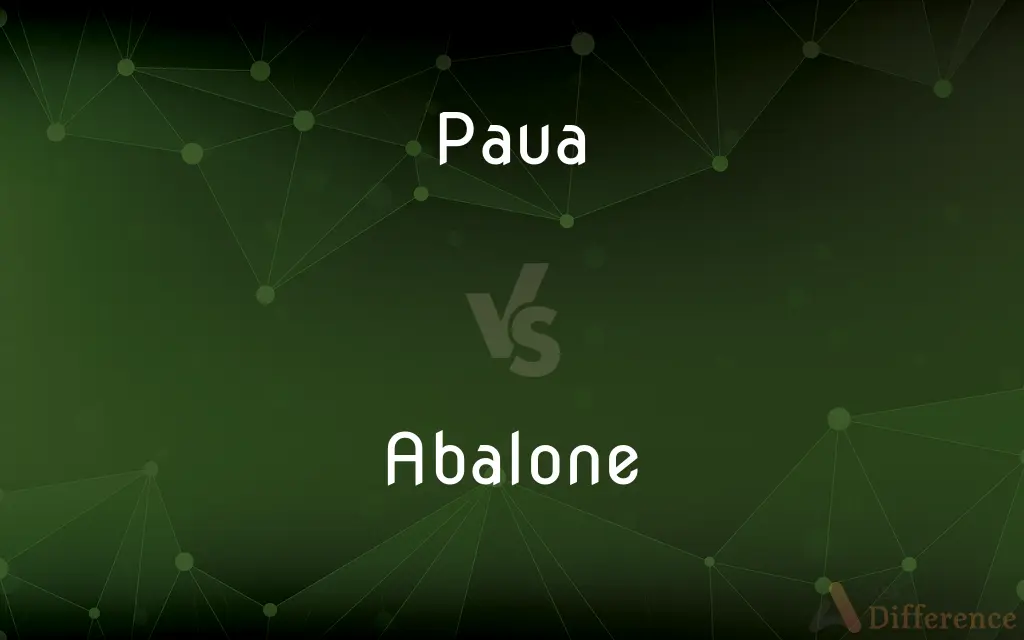Paua vs. Abalone — What's the Difference?
By Tayyaba Rehman & Fiza Rafique — Updated on March 31, 2024
Paua is a type of abalone found exclusively in New Zealand, known for its vibrant shell colors, while abalone refers to a wider group of marine snails worldwide.

Difference Between Paua and Abalone
Table of Contents
ADVERTISEMENT
Key Differences
Paua and abalone both refer to marine mollusks, yet they distinguish themselves through geographic and aesthetic differences. Paua, exclusive to New Zealand waters, is renowned for its strikingly colorful shell, a result of its unique diet and environment. On the other hand, abalone, found in various parts of the world including the US, South Africa, and Australia, typically exhibits a more subdued color palette in its shell.
Paua shells are highly valued in Maori culture for their iridescent qualities, often used in jewelry and traditional artwork. This cultural significance underpins the paua's special status in New Zealand, whereas abalone, though also used decoratively and culturally in places like California and Japan, doesn't hold the same unique cultural identity.
Culinary uses of paua and abalone vary by region. In New Zealand, paua is a delicacy, traditionally prepared in stews or fried dishes. Meanwhile, abalone is prized in many cuisines, particularly Asian, for its tender texture and subtle flavor, often served in restaurants as a luxury item.
Conservation efforts differ significantly between paua and abalone, due to their varying levels of vulnerability. Paua populations are closely monitored in New Zealand to prevent overfishing, with strict quotas and size limits. Conversely, abalone, especially in places like California, faces more severe threats from overfishing and environmental changes, leading to more stringent conservation measures.
Comparison Chart
Geographic Location
Exclusive to New Zealand waters
Found worldwide, including US, South Africa
ADVERTISEMENT
Shell Color
Vibrantly colored, iridescent
Generally more subdued colors
Cultural Significance
High in Maori culture for artwork and jewelry
Varied, with some cultural uses in jewelry and decoration
Culinary Uses
Considered a delicacy, used in traditional dishes
Prized in many cuisines, especially Asian, for its tender texture
Conservation Efforts
Strict quotas and size limits in New Zealand
More severe threats globally, leading to stringent measures
Compare with Definitions
Paua
A species of abalone found in New Zealand, distinguished by its colorful shell.
The diver admired the paua's vibrant shell, a treasure of the ocean.
Abalone
Global efforts to protect abalone from overfishing and poaching.
Conservationists are working to replenish abalone populations through breeding programs.
Paua
Paua as a sought-after ingredient in traditional New Zealand dishes.
At the feast, they served a delicious paua stew, a highlight of local cuisine.
Abalone
The external covering of abalone, which is often used in decorative items.
The artist used abalone shells to add a natural sparkle to her sculpture.
Paua
The indigenous culture of New Zealand, which holds paua in high esteem.
In Maori culture, paua shells are used to create beautiful pieces of jewelry.
Abalone
A marine snail found in various parts of the world, valued for its meat and shell.
Abalone has been overfished in many areas, prompting conservation efforts.
Paua
The hard, outer covering of paua, known for its iridescent qualities.
She picked up the paua shell, marveling at its shimmering colors.
Abalone
In some cultures, abalone shells are used in jewelry and as musical instruments.
The musician crafted a unique instrument from an abalone shell, producing a captivating sound.
Paua
Efforts to protect paua populations in New Zealand from overfishing.
The conservation measures for paua include strict quotas to ensure their sustainability.
Abalone
Abalone is a luxury item in many cuisines, especially Asian.
For his gourmet dish, the chef carefully prepared the tender abalone.
Paua
A large, edible abalone, Haliotis iris, native to New Zealand, whose shell is used to make jewelry.
Abalone
Abalone ( (listen) or ; via Spanish abulón, from Rumsen aulón) is a common name for any of a group of small to very large marine gastropod molluscs in the family Haliotidae.Other common names are ear shells, sea ears, and, rarely, muttonfish or muttonshells in parts of Australia, ormer in the UK, perlemoen in South Africa, and the Maori name for three species in New Zealand is pāua.Abalone are marine snails. Their taxonomy puts them in the family Haliotidae, which contains only one genus, Haliotis, which once contained six subgenera.
Paua
The shell of this mollusc.
Abalone
Any of various large edible marine gastropods of the genus Haliotis, having an ear-shaped shell with a row of holes along the outer edge. The colorful pearly interior of the shell is often used for making jewelry or other ornaments. Also called ear shell.
Paua
A fish hook made from this shell.
Abalone
An edible univalve mollusc of the genus Haliotis, having a shell lined with mother-of-pearl.
Abalone
The meat of the aforementioned mollusc.
Abalone
A univalve mollusk of the genus Haliotis. The shell is lined with mother-of-pearl, and used for ornamental purposes; the sea-ear. Several large species are found on the coast of California, clinging closely to the rocks.
Abalone
Any of various large edible marine gastropods of the genus Haliotis having an ear-shaped shell with pearly interior
Common Curiosities
Why is paua important to Maori culture?
Paua shells hold significant value in Maori culture for their use in jewelry and traditional art.
What makes paua different from other abalones?
Paua is specific to New Zealand and is noted for its uniquely vibrant shell colors.
How is abalone prepared in cuisine?
Abalone is prized for its tender texture and is often served in luxury dishes, especially in Asian cuisines.
Are paua shells only found in New Zealand?
Yes, paua is endemic to New Zealand, making their shells unique to the region.
What measures are taken to protect paua in New Zealand?
New Zealand implements strict quotas and size limits to protect paua from overfishing.
Do paua and abalone taste the same?
While they are similar, the taste can vary depending on the species, diet, and preparation method.
Can you eat paua?
Yes, paua is considered a delicacy in New Zealand, often used in traditional dishes.
What are the conservation statuses of paua and abalone?
Both face conservation concerns, but the severity and measures differ, with paua closely monitored in New Zealand and abalone facing global threats.
Is there a cultural significance for abalone shells outside of New Zealand?
Yes, abalone shells are used in various cultures for decoration, jewelry, and even in musical instruments.
How are abalone and paua shells used in art and culture?
They are used in jewelry, decorative items, and traditional art, reflecting their cultural significance and natural beauty.
Can abalone shells be colorful like paua shells?
While abalone shells can have some coloration, paua shells are specifically known for their vibrant and iridescent hues.
What are the main threats to paua and abalone populations?
Overfishing and environmental changes are major threats to both, though specific challenges may vary by region.
Why is abalone considered a luxury food item?
Its scarcity, harvesting difficulty, and delicate flavor make abalone a luxury food item in many cultures.
Are there different species of abalone?
Yes, there are several species of abalone, with paua being a distinctive type found in New Zealand.
How do you identify a paua shell?
Paua shells are identifiable by their bright, iridescent colors, unlike the typically more subdued abalone shells.
Share Your Discovery

Previous Comparison
Peppercorn vs. Pepper
Next Comparison
Unpitted vs. PittedAuthor Spotlight
Written by
Tayyaba RehmanTayyaba Rehman is a distinguished writer, currently serving as a primary contributor to askdifference.com. As a researcher in semantics and etymology, Tayyaba's passion for the complexity of languages and their distinctions has found a perfect home on the platform. Tayyaba delves into the intricacies of language, distinguishing between commonly confused words and phrases, thereby providing clarity for readers worldwide.
Co-written by
Fiza RafiqueFiza Rafique is a skilled content writer at AskDifference.com, where she meticulously refines and enhances written pieces. Drawing from her vast editorial expertise, Fiza ensures clarity, accuracy, and precision in every article. Passionate about language, she continually seeks to elevate the quality of content for readers worldwide.















































